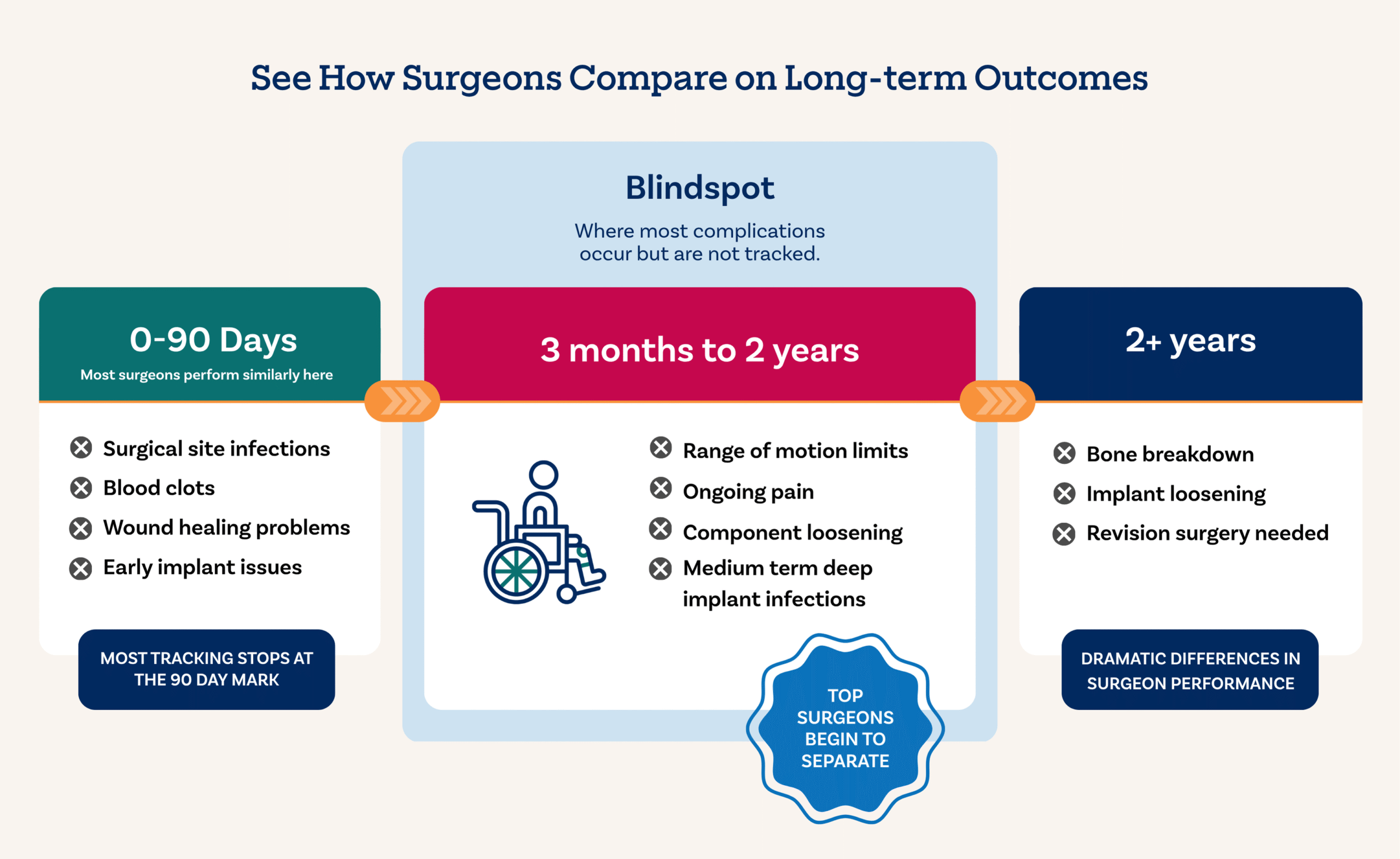When you’re researching knee replacement surgery, you’ll find plenty of information about recovery timelines, early problems, and short-term success rates. But here’s what most patients don’t realize: many knee replacement problems don’t appear until months or years after surgery.
If you’re feeling overwhelmed by this information, you’re not alone. Learning about potential long-term problems is scary when you’re already facing a major surgery. But here’s the encouraging news: top-performing surgeons consistently achieve better long-term outcomes.
They have much lower problem rates years down the road. Understanding what to look for can help you identify these surgeons. This greatly improves your chances of long-term success.
Why the 90-day window falls short
Most hospitals, insurance companies, and evaluation systems track knee replacement outcomes for only 90 days after surgery.
But it creates a serious blind spot for patients. It makes it nearly impossible to identify which surgeons deliver the best long-term results. Your knee replacement journey extends far beyond three months. Some of the most serious problems take much longer to develop. The surgeons who excel at preventing these long-term problems often look similar to average performers in the first 90 days.
That’s exactly why SurgeonCheck analyzes outcomes far beyond the standard 90-day window. By tracking surgeon performance over years, not months, we can identify the top performers. These surgeons consistently deliver excellent long-term results.
Why timing matters: when knee replacement problems actually appear
Think of your knee replacement as a long-term investment, not a quick fix. Different problems emerge at different times. The timeline is longer than most people expect. More importantly, this is where the difference between good surgeons and truly excellent surgeons becomes clear.

Early problems (0-90 days)
During the first three months, healthcare providers closely monitor for immediate issues like:
- Deep implant and superficial infections
- Blood clots (deep vein clots)
- Wound healing problems
- Early implant placement issues
Medium-term problems (3 months to 2 years)
As you move beyond the 90-day mark, different types of problems can emerge. This is where top surgeons begin to separate themselves from the rest:
- Range of motion limits: Scar tissue formation can restrict knee movement
- Ongoing pain: Some patients experience continuing discomfort despite a technically successful surgery
- Implant loosening: The bond between implant and bone may begin to weaken
Outstanding surgeons have lower rates of these medium-term problems. This is due to better surgical technique and implant placement. Medium-term infection generally presents 2 months to 2 years after surgery. This falls outside the typical tracking window.
Late problems (2+ years)
The most concerning developments often occur years after surgery. This is where the difference between top-tier surgeons and average performers becomes most clear:
- Bone breakdown around the implant: Wear particles from the implant can cause bone destruction around the artificial joint
- Implant loosening: Although infection, instability, and kneecap problems dominate as reasons for repeat surgery in the first five years, one of the most frequent late reasons for failure is implant loosening with bone breakdown.
Top surgeons have much lower rates of these late problems. They achieve this through better surgical technique, better implant selection, and more precise placement.
What this means for your surgeon selection
When evaluating potential surgeons, ask these important questions:
- “Can you tell me about patients you operated on 5 years ago? How are they doing now?” Look for surgeons who follow patients for years, not just months.
- “What’s your repeat surgery rate at 5 and 10 years?” This reveals long-term performance that 90-day statistics miss.
- “How do you minimize the risk of late problems like bone breakdown around the implant?” This shows awareness of long-term issues and prevention strategies.
How we track what others miss
At SurgeonCheck, we understand that your knee replacement needs to perform well for decades, not just months. Our evaluation system tracks outcomes far beyond the standard 90-day window. We know that’s when some of the most important problems emerge.
Developed by surgeons who understand what really matters for long-term success, we analyze surgeon performance over multiple years. Our analysis of millions of procedures gives you insight into:
- Long-term repeat surgery rates
- Late infection patterns
- Implant longevity
We never accept payment from surgeons to be recommended. This ensures you get objective, unbiased evaluations based purely on outcome data.
This complete approach helps you identify surgeons who consistently deliver excellent results throughout your knee replacement journey. These are the top performers who distinguish themselves through better long-term outcomes, not just during the initial recovery period.


